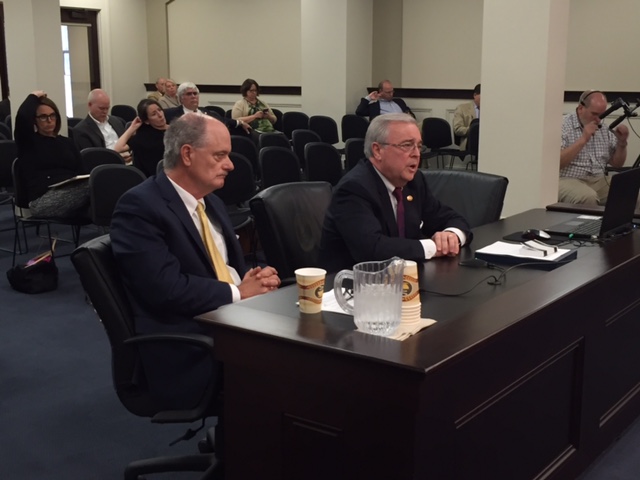
Chief Justice of Kentucky John D. Minton Jr. said Wednesday that the “singular goal of redistricting is to ensure that Kentucky’s judicial resources are allocated appropriately.” His full remarks can be found here.
In testimony before the Interim Joint Committee on State Government at the Capitol Annex, Chief Justice Minton gave an overview of the process and methodology being used to create what is the first judicial redistricting plan for Kentucky trial courts in decades.
“Our judicial circuits and districts have remained largely untouched since the passage of the Judicial Article in 1976 and I would guess at least another 40 years before that,” he said. “There’s no question that the commonwealth has gone through a significant number of changes during that time in terms of caseload and population. And, frankly, we’re learning that the court system has not always kept up with those changes.”
He said the redistricting process began in 2014 after the Judicial Branch budget bill included language requiring the courts to produce a judicial workload assessment that would lead to the formulation of a redistricting plan.
“Unlike redistricting for legislative boundaries, judicial redistricting cannot be accomplished by simply making changes based on population,” he said. “Our process is much more difficult because it impacts commonwealth’s attorneys as well as judges and it is the type of caseload – not population – that ultimately determines the workload of Kentucky’s trial court judges.”
The first step was to measure judicial caseloads by having circuit, family and district judges log how they spent their time handling cases and other judicial duties. The case weights were then put into a formula to get the implied judicial need for each jurisdiction.
The data was then evaluated by the Kentucky Judicial Workload Assessment Committee, which is comprised of judges from each level of the court system as well as circuit court clerks, commonwealth’s attorneys and legislators from throughout the state. The National Center for State Courts compiled the weighted caseloads and implied judicial needs into a report that was vetted by the JWAC members and the Supreme Court. Chief Justice Minton presented the Interim Report of the Kentucky Judicial Workload Assessment to the legislature in February 2016.
The second step is to present a comprehensive judicial redistricting plan to the General Assembly in 2017.
“This is a much more complicated piece of the puzzle,” said Chief Justice Minton. “It involves using the data we’ve collected to either redraw circuit and district boundary lines or reallocate judicial resources across the state, or a combination of the two.”
In November the Supreme Court justices will review a redistricting plan proposed by the JWAC members. Chief Justice Minton said adjustments must be made to add resources in jurisdictions with heavy caseloads and reduce resources where there are lighter caseloads, and that it was becoming clear what a plan would and would not do.
What a redistrict plan would do:
It would make no changes until 2022, when all circuit and district judges are on the ballot.
It would bring Family Court to all but eight jurisdictions.
It would realign a limited number of boundary lines and reallocate existing resources.
It would combine circuits and districts that are currently different.
It would reduce the number of circuits by two, from 57 to 55.
It would calculate the appropriate number of judges by using a 1.4 implied judicial need as the cutoff to determine where more than one judge is needed.
What a redistricting plan would not do:
It would not impact every county or jurisdiction across the state.
It would not accomplish the goal of statewide Family Court, although it gets close.
It would not require additional judgeships to be approved and funded.
“Going forward, I encourage all of us to keep in mind the big picture, which is a state court system positioned to meet the needs of citizens in every county in the commonwealth. That’s good government and the right thing to do. I look forward to working with the legislature to agree on the final plan for judicial redistricting in the coming months.”
Chief Justice Minton said that no matter the end result, he is confident about the data and sound research principles the proposed plan will be based on.
From the Supreme Court of Kentucky





















